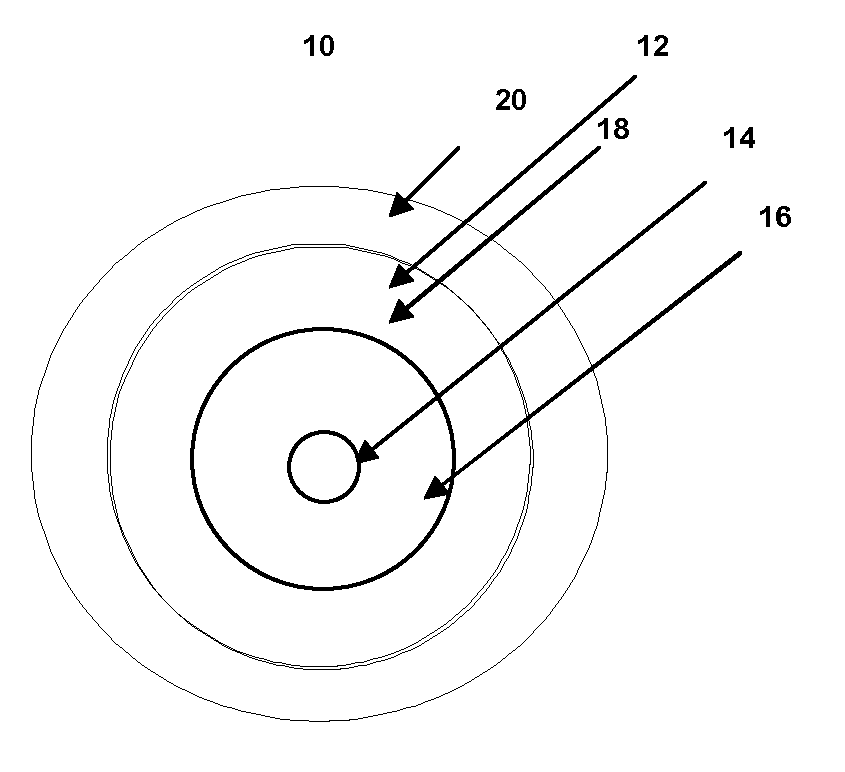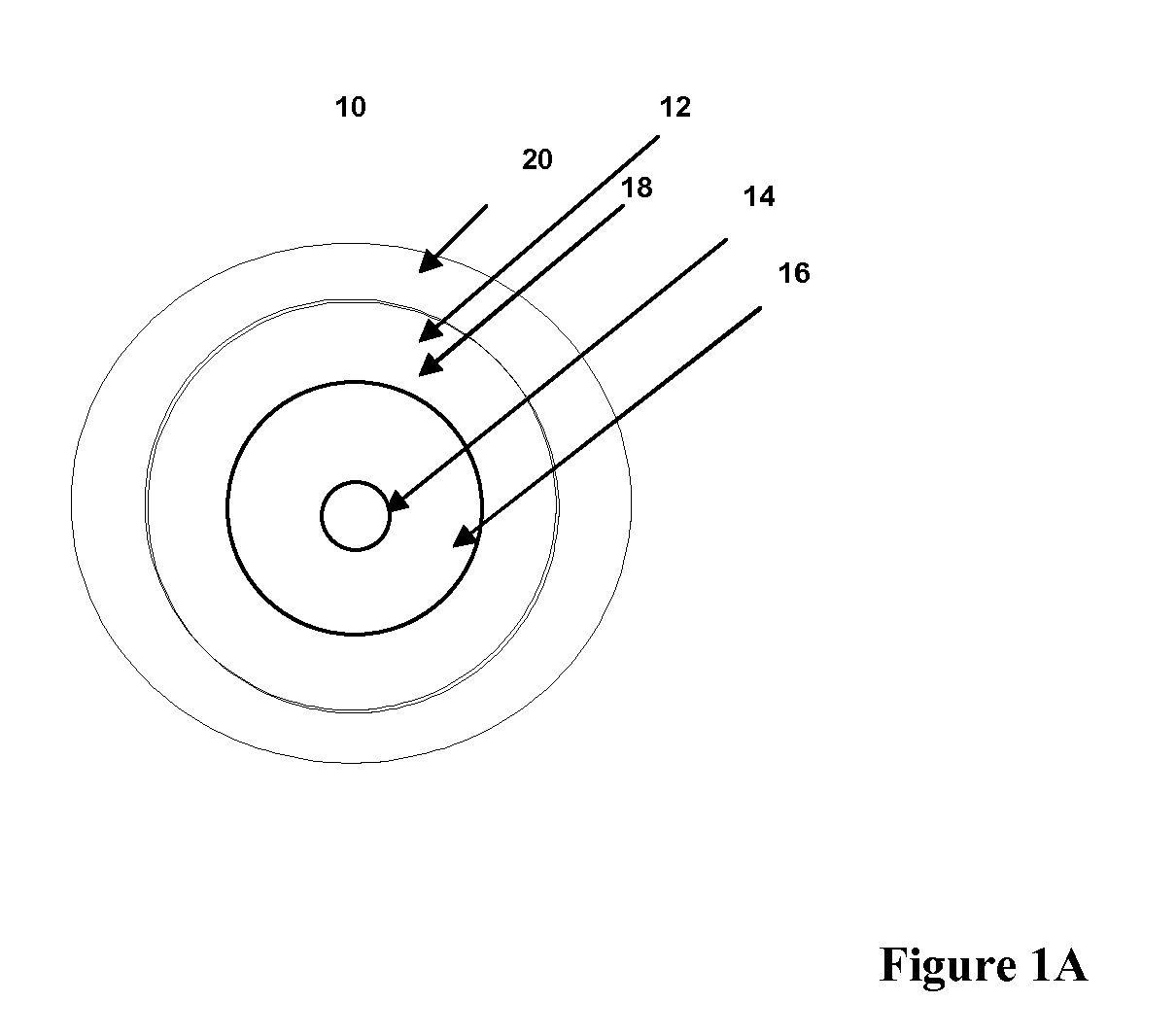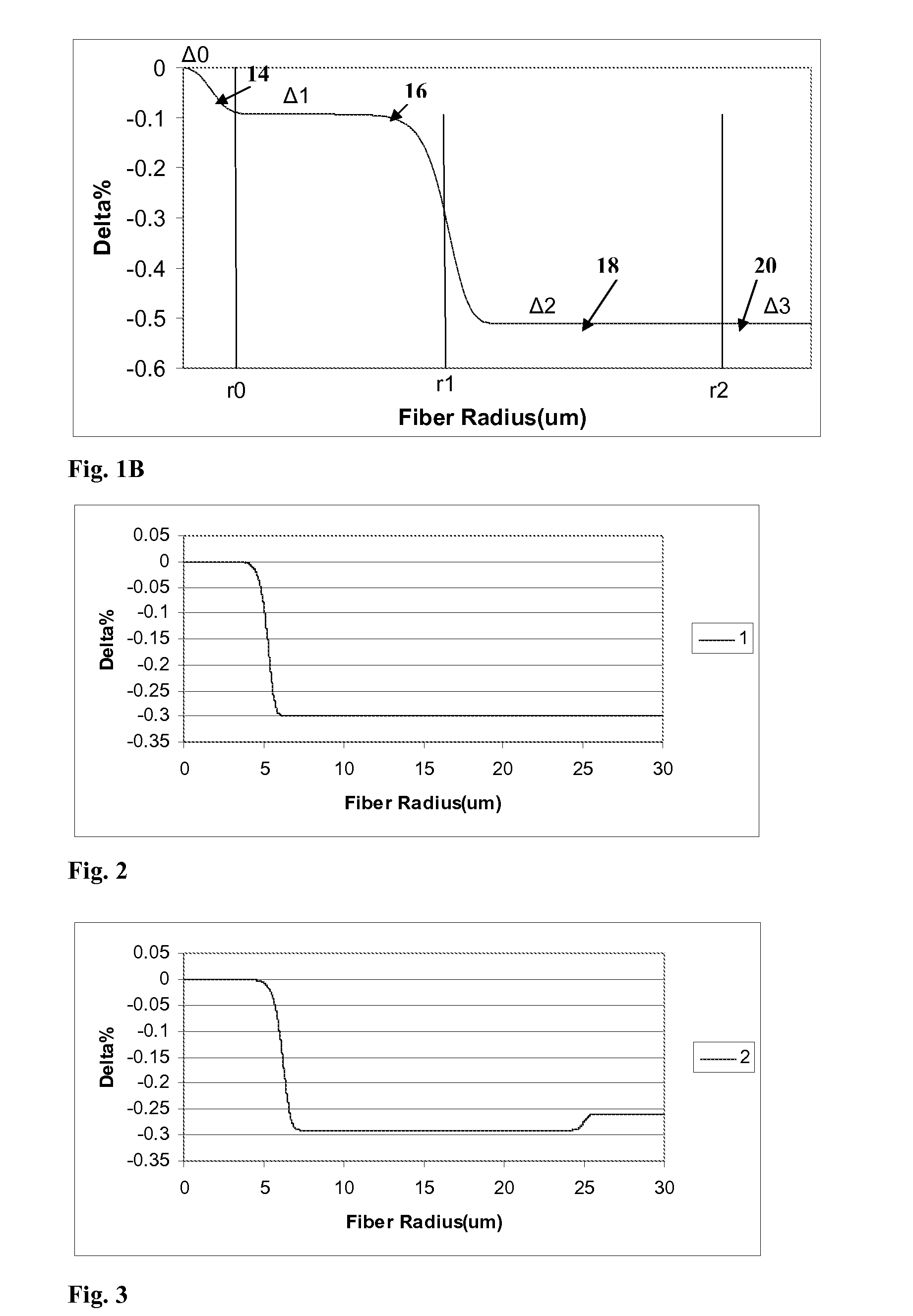Large Effective Area Fiber With GE-Free Core
a technology of ge-free core and effective area, applied in the field of optical fibers, can solve the problems of signal degradation, non-linear optical effect of high-power systems, and high-power systems that suffer from non-linear optical effects
- Summary
- Abstract
- Description
- Claims
- Application Information
AI Technical Summary
Problems solved by technology
Method used
Image
Examples
embodiment (
Embodiment(s) of the invention
[0038]Reference will now be made in detail to the present embodiment(s) of the invention, examples of which are illustrated in the accompanying drawings. Whenever possible, the same reference numerals will be used throughout the drawings to refer to the same or like parts. One embodiment of the optical fiber of the present invention is shown in FIG. 1A, and is designated generally throughout by the reference numeral 10. The waveguide fiber 10 includes a core 12 having an effective area of at about 90 μm2 or more at a 1550 nm wavelength (for example 90 μm2 to 160 μm2, or 100 μm2 to 160 μm2, or 120 to 140 μm2 at a 1550 nm wavelength), and α value 12≦α≦200 (for example 12≦α≦100, or 12≦α≦25), and a cladding 20 surrounding the core. A typical range of a values in the exemplary fibers described herein is 14 to 20, for example 15≦α≦17. However, larger a values (e.g., >25) can be achieved by plasma chemical vapor deposition (PCVD). The exemplary refractive inde...
examples 1-15
[0048]The invention will be further clarified by the following examples.
[0049]Tables 1-2 list characteristics of Examples 1-15 of one illustrative set of fiber embodiments. FIGS. 2-16 show the refractive index profiles corresponding to Examples 1-15, respectively. In these optical fiber embodiments of Examples 1-15, −0.5%≦Δ0=≦0% and Δ0max=≦0%; −0.065%≦Δ1(r=2.5 μm)≦0%, −0.065%≦Δ1max≦0.0%, −0.5%≦Δ2MIN≦−0.27%, −0.4%≦Δ3≦−0.2%, and r2 / r1 is 2.17≦r2 / r1≦5.7 and r20 may be somewhat larger or smaller than 0% (relative to silica), depending on whether updopants or downdopants are present in the center core region 14. Although some embodiments of the optical fibers 10 have alpha values between 12 and 25, optical fiber embodiments of Examples 1-9 have alpha values in the range of 13-15. Optical fiber embodiments of Examples 10-15 have alpha values of about 20.
[0050]The modeled profile parameters of these exemplary fibers are summarized in Table 1A. The values for r3 correspond to the outer diam...
examples 16-23
Fiber Examples 16-23
[0057]Modeled refractive index profiles of two embodiments of the optical fiber 10 of the present invention (Fiber Examples 16 and 17) are shown in FIG. 17. The optical fibers include a core 12 having an effective area of at about 110 μm2 at 1550 nm wavelength and a cladding 20 surrounding the core. The core 12 includes a pure silica central core region 14 extending radially outwardly from a centerline to a radius 0 μm≦r0≦2 μm, and a first annular core region 16 that extends to the outer radius r1, wherein r1 is about 5 μm. The second annular region 18 surrounds the first annular region and is down-doped relative to the first annular core region 16. The second annular region extends to the outer radius r2, wherein r2 is about 17 μm in Fiber Example 16 and about 25 μm in Fiber Example 17. Table 3A, below lists optical parameters of Fiber Examples 16 and 17.
TABLE 3AOptical parameters for Fiber Examples 16 and 17.PinArray atLat. Load atAeff atDispersion at2 m1550 nm...
PUM
| Property | Measurement | Unit |
|---|---|---|
| area | aaaaa | aaaaa |
| outer radius | aaaaa | aaaaa |
| radius | aaaaa | aaaaa |
Abstract
Description
Claims
Application Information
 Login to View More
Login to View More - R&D
- Intellectual Property
- Life Sciences
- Materials
- Tech Scout
- Unparalleled Data Quality
- Higher Quality Content
- 60% Fewer Hallucinations
Browse by: Latest US Patents, China's latest patents, Technical Efficacy Thesaurus, Application Domain, Technology Topic, Popular Technical Reports.
© 2025 PatSnap. All rights reserved.Legal|Privacy policy|Modern Slavery Act Transparency Statement|Sitemap|About US| Contact US: help@patsnap.com



